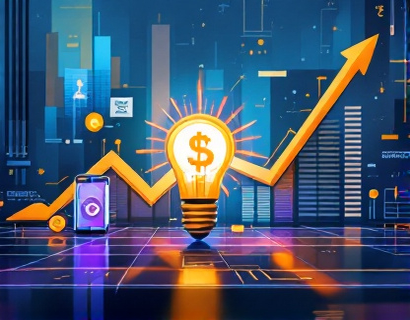Unlocking Strategic Growth: Leveraging Advanced Technology for Informed Decision-Making in Global Capital Markets
In the fast-paced and increasingly complex world of global capital markets, financial analysts and decision-makers face unprecedented challenges and opportunities. The integration of advanced technologies offers a transformative pathway to unlock strategic growth and maintain a competitive edge. This article delves into the critical role of technology in enhancing decision-making processes, providing actionable strategies and deep insights for professionals navigating the dynamic financial landscape.
The landscape of global capital markets is characterized by volatility, complexity, and rapid change. Traditional methods of analysis, while foundational, often fall short in providing the depth and speed required to make informed decisions. Advanced technologies such as artificial intelligence, machine learning, big data analytics, and blockchain offer powerful tools to overcome these limitations. By leveraging these technologies, financial professionals can gain unprecedented insights, automate complex processes, and drive strategic growth.
Enhancing Data Analysis with Big Data Analytics
Big data analytics stands out as a cornerstone technology for modern financial analysis. The ability to process and analyze vast volumes of structured and unstructured data in real-time provides a comprehensive view of market dynamics. This capability is crucial for identifying trends, patterns, and anomalies that traditional methods might miss.
Financial institutions can harness big data to perform predictive analytics, enabling them to forecast market movements and consumer behavior with greater accuracy. For instance, by analyzing social media sentiment, economic indicators, and transaction data, analysts can gauge market sentiment and potential shifts in investor behavior. This proactive approach allows for timely adjustments to investment strategies and risk management practices.
Moreover, big data analytics facilitates the integration of alternative data sources, such as satellite imagery, sensor data, and non-traditional financial reports. These sources can provide unique insights into sectors like real estate, agriculture, and infrastructure, which are often underrepresented in conventional data sets. By incorporating these diverse data streams, financial analysts can develop more robust and nuanced models for valuation and risk assessment.
Leveraging Artificial Intelligence and Machine Learning
Artificial intelligence (AI) and machine learning (ML) are revolutionizing the way financial data is analyzed and interpreted. These technologies can automate routine tasks, freeing up analysts to focus on higher-value activities such as strategic planning and decision-making.
One of the primary applications of AI and ML in capital markets is algorithmic trading. These systems use sophisticated algorithms to execute trades at optimal times, based on predefined criteria and real-time market data. This not only enhances trading efficiency but also reduces human error and emotional bias, leading to more consistent and profitable outcomes.
Beyond trading, AI and ML can significantly improve risk management. By analyzing historical data and identifying patterns, these technologies can predict potential risks and suggest mitigation strategies. For example, machine learning models can assess credit risk by evaluating a wide range of factors, including financial statements, market conditions, and macroeconomic indicators. This holistic approach enables more accurate credit scoring and portfolio optimization.
Additionally, AI-driven natural language processing (NLP) can analyze vast amounts of textual data, such as news articles, earnings reports, and analyst comments. By extracting key insights and sentiment from this unstructured data, financial analysts can gain a deeper understanding of market dynamics and make more informed decisions.
Blockchain Technology for Transparency and Security
Blockchain technology offers a transformative solution for enhancing transparency and security in financial transactions. By providing a decentralized, immutable ledger, blockchain ensures that all transactions are recorded accurately and cannot be altered. This level of transparency is particularly valuable in areas such as trade finance, where multiple parties need to verify and validate transactions.
Smart contracts, a key feature of blockchain, automate and enforce contractual obligations without the need for intermediaries. This not only reduces transaction costs but also minimizes the risk of fraud and errors. For instance, in cross-border payments, smart contracts can streamline the process by automatically executing payments when predefined conditions are met, such as the verification of documents or the completion of customs clearance.
Furthermore, blockchain can enhance the traceability of assets, from raw materials to finished products. In industries like mining and manufacturing, blockchain can track the origin and movement of goods, ensuring compliance with regulatory standards and ethical sourcing practices. This transparency builds trust among stakeholders and can lead to new business opportunities and partnerships.
Cloud Computing for Scalability and Flexibility
Cloud computing has become an essential infrastructure for financial institutions looking to scale their operations and adapt to changing market conditions. Cloud platforms offer on-demand access to computing resources, storage, and software services, enabling financial firms to quickly scale up or down based on their needs.
One of the key benefits of cloud computing is its cost-effectiveness. By eliminating the need for extensive on-premises hardware and maintenance, financial institutions can reduce capital expenditures and operational costs. This flexibility is particularly important for startups and smaller firms that may not have the resources to invest in expensive IT infrastructure.
Cloud computing also facilitates collaboration and data sharing across different departments and geographies. Financial analysts can access real-time data and collaborative tools from anywhere in the world, enhancing productivity and decision-making. Moreover, cloud providers often offer advanced security features, ensuring that sensitive financial data is protected against cyber threats.
Internet of Things (IoT) for Enhanced Insights
The Internet of Things (IoT) is another technology with significant potential in the financial sector. IoT devices, ranging from sensors in industrial equipment to wearable devices, generate a wealth of data that can be leveraged for financial analysis and decision-making.
In the realm of corporate finance, IoT can provide real-time insights into operational efficiency and asset performance. For example, sensors installed in manufacturing plants can monitor equipment health, predict maintenance needs, and optimize production processes. This data can be used to improve asset utilization, reduce downtime, and lower operational costs.
In the area of consumer finance, IoT devices can enhance credit risk assessment by providing a more comprehensive view of an individual's financial behavior. For instance, data from mobile payments, utility usage, and transportation habits can be analyzed to create a more accurate profile of a consumer's creditworthiness. This approach can lead to better lending decisions and personalized financial products.
Cybersecurity: A Critical Component
As financial institutions increasingly adopt advanced technologies, cybersecurity becomes a paramount concern. The integration of AI, blockchain, cloud computing, and IoT introduces new vulnerabilities that must be addressed to protect sensitive financial data and maintain stakeholder trust.
Financial firms must invest in robust cybersecurity measures, including advanced threat detection systems, encryption technologies, and regular security audits. Employee training and awareness programs are also essential to prevent human errors that could compromise security. By prioritizing cybersecurity, financial institutions can safeguard their operations and ensure the integrity of their data-driven decision-making processes.
Conclusion
In conclusion, the integration of advanced technologies such as big data analytics, AI, machine learning, blockchain, cloud computing, and IoT offers significant opportunities for financial analysts and decision-makers in global capital markets. These technologies enhance data analysis, automate processes, improve risk management, and provide new insights, ultimately driving strategic growth and competitive advantage.
However, the successful adoption of these technologies requires a strategic approach, including investment in infrastructure, talent development, and a strong focus on cybersecurity. By embracing these advancements, financial professionals can navigate the complexities of the global capital markets with greater confidence and precision, unlocking new possibilities for growth and success.










































